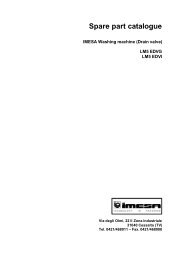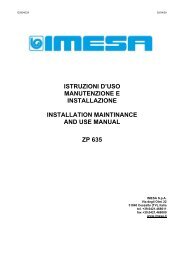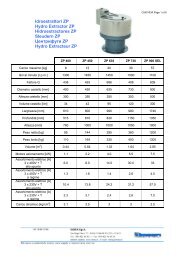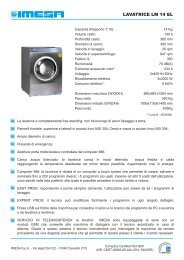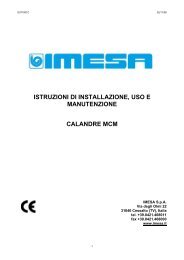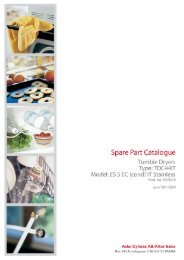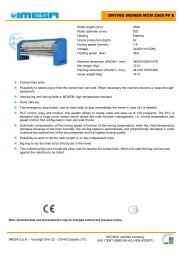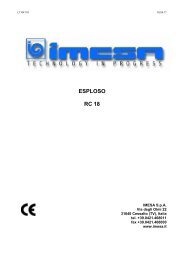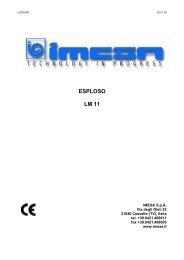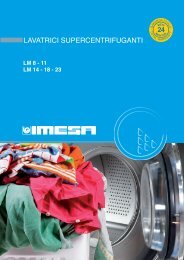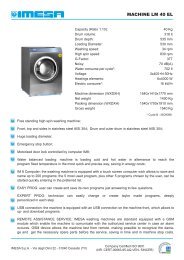S/EP1 - S/EP3 S/EP4 - S/EP5 - IMESA SpA
S/EP1 - S/EP3 S/EP4 - S/EP5 - IMESA SpA
S/EP1 - S/EP3 S/EP4 - S/EP5 - IMESA SpA
Create successful ePaper yourself
Turn your PDF publications into a flip-book with our unique Google optimized e-Paper software.
16<br />
After draining, close the tap.<br />
6.10 SAFETY DEVICES<br />
The safety devices installed on the machine are<br />
calibrated by the manufacturer.<br />
The user is not permitted to tamper with these<br />
devices.<br />
6.11 PUMP<br />
The pump (tav.22-ref.1) does not require any special<br />
maintenance.<br />
If the pump has not been active for a long period of<br />
time, check if there is any water in the body and check<br />
that the shaft rotates freely.<br />
6.12 VACUUM<br />
• Frequently check the vacuum (tav.31-ref.1) during<br />
the first 48 hours of operation paying attention<br />
clamping of the bolts.<br />
• General maintenance of the vacuum should be<br />
carried out every three months.<br />
• Periodically clean the impeller.<br />
6.13 PERIODICAL INSPECTIONS<br />
Every two years, check the condition of the boiler<br />
material for corrosion-make sure that minimum<br />
thicknesses are not lower than:<br />
- surround 4 mm;<br />
- base 3,5 mm.<br />
Every 12 months, check the efficiency of the safety<br />
valve (set pressure 5,6 bar) and of the safety<br />
thermostat (activated at temperature of 180°C).<br />
Should they not function correctly, stop the machine<br />
and call our after sales service.<br />
7 TROUBLE SHOOTING<br />
ATTENTION<br />
All the operations in this section and especially<br />
the one described in paragraph 7.11 must be<br />
carried out by qualified engineers.<br />
7.1 THERE IS NO STEAM ISSUE<br />
• The steaming solenoid valve (tav.20-ref.7) or only<br />
the coil (tav.24-ref.3) is faulty: replace the faulty<br />
part.<br />
• The pedal micro-switch (tav.25÷29C-ref.10) or<br />
(tav.27÷29-ref.32) or the button (tav.25÷29C-ref.7)<br />
is faulty: replace.<br />
• The steam timer (tav.01÷04-ref.16) is faulty: replace<br />
if the machine is so equipped.<br />
7.2 THE VACUUM DOES NOT START<br />
• Motor of vacuum (tav.31-ref.2), when the machine<br />
is so equipped, is burnt out: replace or re-wind.<br />
• Fuse burnt out: replace.<br />
• Contactor coil (tav.30÷30C-ref.11) burnt out:<br />
replace.<br />
• Switch (tav.30÷30C-ref.19) faulty: replace.<br />
7.3 THE VACUUM TURNS BUT VACUUM IS INSUFFICIENT<br />
• The table cover (tav.18-19) is obstructed: replace.<br />
• The vacuum fan (tav.31-ref.3) is dirty: clean.<br />
7.4 THE TOP BUCK DOES NOT CLOSE<br />
• Disactivate the block on the top buck, by means of<br />
the button (tav.27÷29C-ref.39).<br />
• Lack of air in the machine at 6 bar pressure. Check<br />
on the pressure gauge (tav.01-ref.13).<br />
• No air goes through the closing valve positioned<br />
below the button (tav.25/25A/26-ref.7, 2 button<br />
version); no air goes through the valve positioned<br />
above the pedal (tav.27/28/29-ref.10, in version with<br />
lowering by pedal and safety guard); or no air goes<br />
through the valve positioned below the button<br />
(tav.29A/29B/29C-ref.7 in version with the buttons<br />
and safety guard). Replace the faulty part.<br />
• The AND component does not work (tav.25÷29Cref.12):<br />
replace.<br />
7.5 THE TOP BUCK DOES NOT OPEN<br />
• The amplified valve positioned at the air inlet of the<br />
cylinder does not open (tav.25÷29C-ref.8): replace.<br />
7.6 THE TOP BUCK OPENS SLOWLY - REGULATION<br />
• To adjust the closing speed of the top buck, the<br />
screw “A” of the shock absorber should be turned<br />
(tav.17A-ref.7) in the clockwise direction to reduce<br />
and in the anti-clockwise direction to increase.<br />
• To regulate the speed of ascent of the top buck,<br />
the screw “B” of the shock sbsorber should be<br />
turned (tav.17A-ref.7) in the clockwise direction to<br />
reduce and in the anti-clockwise direction to<br />
increase.<br />
7.7 TOO MUCH WATER ENTERS THE BOILER<br />
• The level control (tav.30÷30C-ref.3) is faulty: replace<br />
the entire component.<br />
• On the level probe rod (tav.20-ref.5) there are<br />
calcium deposit: clear.<br />
• Feed solenoid valve (tav.20-ref.2) is faulty.<br />
7.8 IF WATER DOES NOT ENTER THE BOILER<br />
If the level control is faulty (tav.30÷30C-ref.3), it is<br />
possible that the pump stops sending water to the boiler,<br />
thereby causing overheating of the elements.<br />
To avoid the elements burning out, the machine is<br />
equipped with a probe thermostat (tav.20-ref.16) which<br />
cuts power to the elements when they have reached a<br />
certain temperature; if this occurs, the red warning lamp<br />
(tav.01-ref.21) on the electric panel, comes on.<br />
To re-start the boiler, first of all let it cool down, then<br />
replace the level control, checking the electric circuit and<br />
lastly re-arm the probe thermostat by pressing the button<br />
on the body of the thermostat.<br />
7.9 THE ELEMENTS ARE ACTIVATED BUT THE BOILER<br />
DOES NOT REACH PRESSURE LEVEL<br />
• The heating elements (tav.20-ref.13) are cut out<br />
and no power is getting through: replace.



